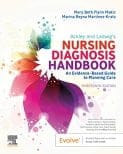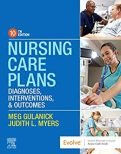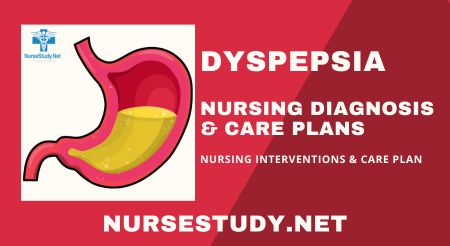Last updated on July 8th, 2023 at 01:37 pm
Nursing Diagnosis Definition for Dyspepsia:
Dyspepsia is characterized by discomfort or pain in the upper abdomen, often accompanied by bloating, early satiety, nausea, or a feeling of fullness.
It is typically associated with impaired digestion and may be caused by various factors, such as gastrointestinal disorders, dietary habits, or psychological stress.
Defining Characteristics of Dyspepsia:
Subjective:
- Complaints of abdominal discomfort or pain, often described as burning, gnawing, or aching.
- Sensation of fullness or bloating after meals.
- Early satiety or feeling full quickly.
- Nausea or a general sense of indigestion.
Objective:
- Abdominal tenderness upon palpation.
- Evidence of poor appetite or weight loss.
- Epigastric distension or bloating.
- Regurgitation or heartburn.
Related Factors:
- Gastrointestinal disorders, such as gastritis, peptic ulcer disease, or gastroesophageal reflux disease (GERD).
- Poor dietary habits, including excessive intake of spicy, fatty, or acidic foods.
- Psychological stress or anxiety.
- Medications that may irritate the gastric mucosa, such as nonsteroidal anti-inflammatory drugs (NSAIDs) or certain antibiotics.
Risk Population:
Individuals who are at an increased risk of developing dyspepsia include those with a history of gastrointestinal disorders, individuals with high levels of stress, people with poor dietary habits, and those taking medications that may affect gastric mucosal integrity.
Associated Problems:
- Malnutrition or inadequate nutrient intake.
- Weight loss or failure to thrive.
- Decreased quality of life due to chronic discomfort.
- Impaired sleep patterns due to nocturnal symptoms.
- Anxiety or psychological distress related to the chronic nature of dyspepsia.
Suggestions for Use:
- Conduct a thorough assessment of the client’s symptoms, medical history, and dietary habits.
- Collaborate with other healthcare professionals, such as physicians or dietitians, to develop a comprehensive care plan.
- Educate the client about lifestyle modifications, dietary changes, and stress management techniques.
- Monitor and evaluate the client’s response to treatment and adjust the plan of care as needed.
Suggested Alternative NANDA Diagnoses:
- Imbalanced Nutrition: Less Than Body Requirements
- Anxiety
- Ineffective Coping
- Acute Pain
- Sleep Pattern Disturbance
Usage Tips:
- Document specific details about the client’s symptoms, such as the nature, severity, and duration of abdominal discomfort.
- Regularly reassess and update the care plan based on the client’s response to interventions.
- Involve the client in the decision-making process and encourage self-care strategies.
- Collaborate with the interdisciplinary team to provide holistic care.
NOC Outcomes:
- Nutritional Status
- Pain Level
- Coping
- Sleep
- Anxiety Level
NOC Results:
- Improved nutritional status with appropriate weight gain or maintenance.
- They have reduced pain associated with dyspepsia.
- Effective coping mechanisms to manage dyspepsia-related distress.
- Improved sleep patterns with minimal disruption.
- Decreased anxiety levels related to dyspepsia.
NIC Interventions:
- Nutritional Counseling
- Pain Management
- Stress Management
- Education: Medication
- Dietary Management
- Sleep Enhancement Techniques
Nursing Care Plan for Dyspepsia
Imbalanced Nutrition: Less Than Body Requirements Nursing Care Plan for Dyspepsia:
Nursing Diagnosis: Imbalanced Nutrition: Less Than Body Requirements related to impaired digestion and decreased intake of nutrients secondary to dyspepsia.
Related Factors/Causes:
- Impaired digestion due to gastrointestinal disorders (e.g., gastritis, peptic ulcer disease, GERD).
- Decreased appetite or early satiety associated with dyspepsia symptoms.
- Poor dietary habits, including avoidance of certain foods due to fear of exacerbating dyspepsia symptoms.
Desired Outcomes:
- The client will achieve and maintain adequate nutritional intake.
- The client will demonstrate appropriate weight gain or maintenance.
- The client will report improved energy levels and overall well-being.
Dyspepsia Nursing Interventions:
- Assess the client’s current dietary intake, including meal patterns, food preferences, and any specific foods that exacerbate dyspepsia symptoms.
- Collaborate with a registered dietitian to develop an individualized meal plan that includes foods that are easily digested, well-tolerated, and provide adequate nutrients.
- Educate the client about the importance of balanced nutrition and the role of specific nutrients in promoting healing and overall health.
- Encourage the client to eat small, frequent meals to reduce the sensation of fullness and bloating.
- Provide information and support regarding strategies to manage dyspepsia symptoms during meals, such as chewing food thoroughly, eating slowly, and avoiding triggers (e.g., spicy or fatty foods).
- Monitor the client’s weight regularly to evaluate progress and adjust the meal plan as needed.
- Collaborate with the healthcare team to address any underlying gastrointestinal disorders contributing to impaired digestion.
- Assess the client’s psychological and emotional well-being, as stress and anxiety can impact appetite and digestion. Provide appropriate interventions and referrals for counseling or stress management.
- Document the client’s nutritional intake, weight changes, and any improvements in dyspepsia symptoms to track progress and guide further interventions.
Evaluation:
- The client demonstrates an increase in nutritional intake, consuming meals according to the recommended meal plan.
- The client achieves and maintains appropriate weight gain or maintenance.
- The client reports improved energy levels and overall well-being.
- Dyspepsia symptoms are reduced or alleviated, leading to improved appetite and digestion.
Anxiety Nursing Care Plan for Dyspepsia:
Nursing Diagnosis: Anxiety related to the chronic nature of dyspepsia and its impact on daily life.
Related Factors/Causes:
- Uncertainty and fear related to the chronic nature of dyspepsia symptoms.
- Worries about the impact of dyspepsia on social interactions, work, or school performance.
- Psychological distress caused by the discomfort and unpredictability of dyspepsia symptoms.
Desired Outcomes:
- The client will report reduced anxiety levels.
- The client will utilize effective coping mechanisms to manage anxiety related to dyspepsia.
- The client will demonstrate improved ability to engage in daily activities despite dyspepsia-related anxiety.
Nursing Interventions for Dyspepsia:
- Establish a therapeutic relationship with the client, providing a supportive and nonjudgmental environment.
- Assess the client’s anxiety levels using appropriate assessment tools and subjective reports.
- Educate the client about dyspepsia, its causes, and treatment options to increase understanding and reduce uncertainty.
- Teach relaxation techniques, such as deep breathing exercises, guided imagery, or progressive muscle relaxation, to help manage anxiety symptoms.
- Encourage the client to express feelings and concerns related to dyspepsia and provide emotional support.
- Collaborate with the healthcare team to address and manage underlying dyspepsia symptoms that contribute to anxiety.
- Discuss and explore coping strategies with the client, such as engaging in hobbies, participating in relaxation activities, or seeking social support.
- Refer the client to a mental health professional, such as a therapist or counselor, for additional support and counseling if necessary.
- Monitor the client’s progress in managing anxiety and provide regular reassessment and feedback.
Evaluation:
- The client reports reduced anxiety levels and demonstrates improved coping skills.
- The client utilizes relaxation techniques effectively to manage anxiety related to dyspepsia.
- The client is able to engage in daily activities despite dyspepsia-related anxiety.
- The client demonstrates an increased sense of control and improved overall well-being.
Dyspepsia Nursing Practice Questions
Question 1: A client presents to the clinic with complaints of abdominal discomfort, bloating, and early satiety after meals. The nurse suspects the client is experiencing dyspepsia. Which intervention should the nurse prioritize in the plan of care for this client?
A) Administer antacids as needed for symptom relief.
B) Teach the client relaxation techniques to manage anxiety.
C) Collaborate with a dietitian to develop a modified meal plan.
D) Refer the client to a gastroenterologist for further evaluation.
Answer: C) Collaborate with a dietitian to develop a modified meal plan.
Rationale: Dyspepsia is often related to impaired digestion and may be influenced by dietary factors. Collaborating with a dietitian to develop a modified meal plan can help alleviate symptoms and improve the client’s overall well-being.
Question 2: The nurse is providing education to a client diagnosed with dyspepsia. Which statement by the client indicates an understanding of self-care measures for managing dyspepsia symptoms?
A) “I will avoid eating any fats or oils.”
B) “I should eat large meals to prevent frequent snacking.”
C) “I will eat slowly and chew my food thoroughly.”
D) “I need to eliminate all carbohydrates from my diet.”
Answer: C) “I will eat slowly and chew my food thoroughly.”
Rationale: Eating slowly and chewing food thoroughly can aid in digestion and reduce dyspepsia symptoms. It allows for better breakdown of food and promotes proper absorption.
Question 3: A client with dyspepsia is prescribed a proton pump inhibitor (PPI) medication. The nurse understands that the primary action of PPIs is to:
A) Reduce gastric acid production.
B) Increase gastric motility.
C) Enhance esophageal sphincter tone.
D) Protect the gastric mucosa from erosion.
Answer: A) Reduce gastric acid production.
Rationale: Proton pump inhibitors (PPIs) work by inhibiting the action of the gastric proton pump, which reduces the production of gastric acid. This helps alleviate dyspepsia symptoms associated with excess acid production.
Question 4: The nurse is assessing a client with dyspepsia and notes abdominal tenderness upon palpation. Which condition should the nurse suspect as a possible cause of the client’s symptoms?
A) Gastritis
B) Gallstones
C) Pancreatitis
D) Diverticulitis
Answer: A) Gastritis
Rationale: Abdominal tenderness upon palpation is a characteristic finding in clients with gastritis, which is inflammation of the gastric mucosa. Gastritis can contribute to dyspepsia symptoms, including abdominal discomfort and pain.
Question 5: A client with dyspepsia asks the nurse about lifestyle modifications to manage the condition. Which recommendation should the nurse provide to the client?
A) Avoid consuming any form of dairy products.
B) Limit intake of spicy and acidic foods.
C) Increase consumption of carbonated beverages.
D) Engage in vigorous exercise immediately after meals.
Answer: B) Limit intake of spicy and acidic foods.
Rationale: Spicy and acidic foods can exacerbate dyspepsia symptoms. Limiting the consumption of these foods can help manage symptoms and improve overall comfort for the client.
Nursing References
Ackley, B. J., Ladwig, G. B., Makic, M. B., Martinez-Kratz, M. R., & Zanotti, M. (2020). Nursing diagnoses handbook: An evidence-based guide to planning care. St. Louis, MO: Elsevier.
Gulanick, M., & Myers, J. L. (2022). Nursing care plans: Diagnoses, interventions, & outcomes. St. Louis, MO: Elsevier.
Ignatavicius, D. D., Workman, M. L., Rebar, C. R., & Heimgartner, N. M. (2020). Medical-surgical nursing: Concepts for interprofessional collaborative care. St. Louis, MO: Elsevier.
Silvestri, L. A. (2020). Saunders comprehensive review for the NCLEX-RN examination. St. Louis, MO: Elsevier.
Best Nursing Books and Resources
These are the nursing books and resources that we recommend.
NurseStudy.net is a participant in the Amazon Services LLC Associates Program. Included below are affiliate links from Amazon at no additional cost from you. We may earn a small commission from your purchase. Please see our Privacy Policy

The Nursing Diagnosis Handbook E-Book: An Evidence-Based Guide to Planning Care
This is an excellent reference for nurses and nursing students. While it is a great resource for writing nursing care plans and nursing diagnoses, it also helps guide the nurse to match the nursing diagnosis to the patient assessment and diagnosis.
This handbook has been updated with NANDA-I approved Nursing Diagnoses that incorporates NOC and NIC taxonomies and evidenced based nursing interventions and much more.

NANDA International Nursing Diagnoses: Definitions & Classification, 2021-2023
All introductory chapters in this updated version of a ground-breaking text have been completely rewritten to give nurses the knowledge they require to appreciate assessment, its relationship to diagnosis and clinical reasoning, and the goal and use of taxonomic organization at the bedside.

Nursing Care Plans: Nursing Diagnosis and Intervention
It contains more than 200 care plans that adhere to the newest evidence-based recommendations.
Additionally, it distinguishes between nursing and collaborative approaches and highlights QSEN competencies.
Disclaimer:
Please follow your facilities guidelines, policies, and procedures.
The medical information on this site is provided as an information resource only and is not to be used or relied on for any diagnostic or treatment purposes.
This information is intended to be nursing education and should not be used as a substitute for professional diagnosis and treatment.


